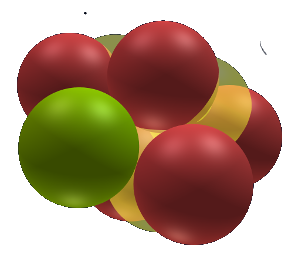Phosphorus 31
"strangely" the configuration of a Li nuclet and a Carbon nuclet is not avaiable in the periodic table. The number of protons in that case would be 29 where one would expect this element to be in the normal order. This "strange"effect is also seen on the 18 Proton element which is not Oxygen 18 but an Carbon central nuclet plus a Li nuclet, This element is missing as well. Therefore a recurring regularity is that a Li nuclet is not a very preferred state, in the sense that it is very likely highly "reactive" and will readily take on more Protons to form a Be nuclet.
Also this can be a result of only being able to grow beyond the neutral 5 ending through adding for example a He atom (Alpha radiation) which results in the Be ending. This needs more attention!
The Beryllium nuclet provides strength for the (6th Lithium) proton. When not supported it is prone to decay to an extra neutron state on the Carbon nuclet. (Beta + decay / Electron capture)
| Element | |
| Valence | *5, 4, *3, 2, 1, 0, -1, -2, *-3 |
| Stability |
|
| Isotope | |
| Abundance |
100.00 %
|
| Half Life |
Stable
|
| Decay | |
| Protons |
31
|
| Inner Electrons |
16
|
| Outer Electrons |
15
|
| Nuclear Spin |
1/2+
|
| Mass Actual |
30.9738 AMU
|
| Mass H Norm |
30.7333 AMU
|
| Mass Calc |
31.2426 AMU
|
| BE Nucleon |
8481.17 KeV
|
| BE Actual |
262.92 MeV
|
| SAM Lines |
118.00
|
| BE SAM Lines |
262.55 MeV
|
| BE Difference |
99.86%
|
| AN-ISOTOPE |
15: 31
|
| Nid | 282 |
state: final
protons:
P0:
P1:
P2:
P3:
P4:
P5:
P6:
P7:
P8:
P9:
P10:
P11:
electrons:
E01: {protons: [P8, P2]}
E02: {protons: [P5, P10]}
E03: {protons: [P3, P6]}
E04: {protons: [P4, P0]}
E05: {protons: [P1, P11]}
E06: {protons: [P7, P9]}
nuclets:
N00:
state: beryllium
attachAngle: 5
protons:
P1:
P3:
P4:
P5:
P6:
P7:
P9:
P11:
electrons:
E01: {protons: [P3, P5]}
E02: {protons: [P4, P1]}
E03: {protons: [P9, P11]}
E04: {protons: [P6, P7]}
N01:
state: carbon
attachAngle: 3
protons:
P0:
P1:
P2:
P3:
P4:
P5:
P6:
P7:
P8:
P9: {color: proton}
P11:
electrons:
E01: {protons: [P3, P11]}
E02: {protons: [P1, P4]}
E03: {protons: [P0, P7]}
E04: {protons: [P5, P8]}
E05: {protons: [P2, P6]}
